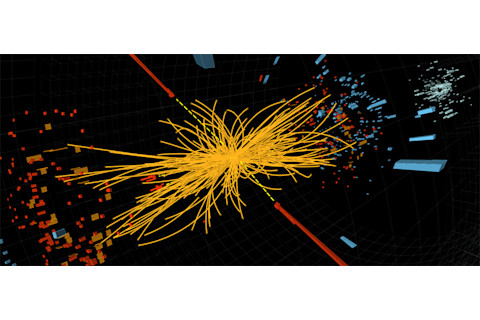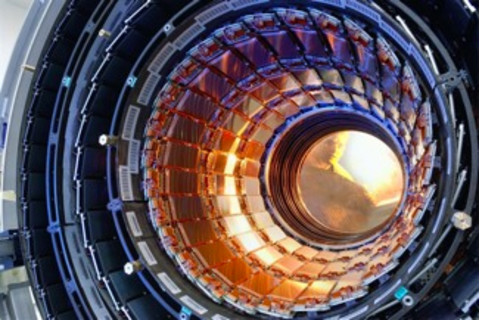Amir D. Aczel has been closely associated with CERN and particle physics for a number of years and often consults on statistical issues relating to physics. He is also the author of 18 popular books on mathematics and science, and has been awarded both Guggenheim Foundation and Sloan Foundation fellowships. Many thanks to Steven Weinberg of the University of Texas at Austin and to Barton Zwiebach of MIT for their helpful comments.

Readers of this blog have probably heard the standard fare about how the Higgs boson "gives mass" to everything in the universe, probably with some kind of analogy, like the one about a famous person walking through a crowded room, pulled every which way by admiring crowds, and that these connections "make the person massive"---as the Higgs field does with particles. Now that we finally seemed to have pinned down the elusive particle, I want to explain where the Higgs came from and what it does. While our understanding of the particle comes from some complicated math, the formulas actually tell a fascinating story, which I'll recount in this post. All you need to keep in mind is that in the modern understanding of physics, categories aren't as starkly separate as you might think: particles can be represented as waves or fields, and a force can also be viewed as a particle or a field. So, a fraction of a second after the Big Bang, the universe had four kinds of "photons" floating around---the usual photon of light, and three other massless particles that "look" and act just like the photon. We label them: W+, W-, and Z. They are bosons, meaning carriers of force, as is the usual photon. At the Big Bang, the universe also had one, unified, mighty force called the Superforce ruling it. But a tiny fraction of a second before the era I am talking about, the Superforce began to break down, successively "shedding off" part of itself to make the force of gravity, and another part of itself to make the strong nuclear force, which later would be active inside the nuclei of all matter, holding quarks inside protons and neutrons once these composite particles came into being. The two forces, gravity and the strong force---important as they are---do not enter our main story today. The remnant we have of the Superforce at the time we are talking about, a tiny fraction of a second after the Big Bang, has three forces of nature held together inside it: electricity, magnetism, and something called the weak nuclear force, which later would be responsible for beta decay, a form of radioactivity. You may remember from a physics course that "electromagnetism" unifies electricity and magnetism, as Maxwell taught us over a century ago. But, during the era I am talking about, there are really three linked forces: electro-magnetic-weak; all three are held together as the electroweak force that remained from the Superforce after it had shed off gravity and the strong force.* In addition to the remnant of the Superforce that included the unified electroweak forces (and the four associated particles: photon, two Ws, and one Z), there is also something that permeates the fledgling cosmos---a strange field: something like the magnetic field around a bar magnet or the Earth, or like the gravitational field around massive objects. But unlike them, it doesn't have an associated direction (such as toward the North Pole, or the center of the Earth); that is, it's a scalar field, not a vector field. Today we call that mysterious entity the Higgs field. The Higgs field is actually comprised of two complex-valued fields linked together. What does this mean? A complex field looks like a plane with imaginary numbers (multiples of i, the square-root of -1) along the vertical axis, and the usual numbers along the horizontal x axis. Now imagine two such fields. You need a bit of imagination to "see" this: think of 2 pieces of paper at right angles to one another, each labeled up-down by i and left-right by x. (But be aware that this is a kind of visual "cheating": we are trying to discern a four-dimensional space within the three dimensions we are stuck in, which isn't literally possible.) So there are really four Higgs particles, each one of them associated with a particular direction of the two complex fields. Thus each of the four spatial directions i,i,x,x, is also a particle.

Now, this four-dimensional Higgs field interacts with the electroweak field, meaning with the three forces, electro-magnetic-weak, and their associated four bosons: the photon of the electromagnetic field and the two Ws and one Z of the weak nuclear field. Imagine this interaction of the two complex Higgs fields with the field of the electroweak force as a further cosmic blast that follows the Big Bang: Here, the 4-Higgs field described above "collides" with the electroweak field, and bam! This cataclysmic event forces three of the Higgses to become absorbed by three of the electroweak bosons, still acting like photons---the W+, the W-, and the Z. As a result of this "collision" the three bosons stop being photon-like and "gain weight" from "eating" one Higgs each. (This is how the physicist Barton Zwiebach of MIT describes this defining event.) This cosmic merger of three Higgs particles with two Ws and one Z still leaves one Higgs free and left over for us to discover (as, indeed, was just announced by CERN on July 4th!), and one still-massless boson of the old electroweak force: the usual photon, the particle (and wave) of light we all know and love---which somehow missed its chance to eat the last remaining Higgs and thus gain its own weight! If it had, we wouldn't be here...the universe would have no light and probably too much radioactivity. So this is the "Higgs mechanism,"** which gave mass to the two Ws and the Z---which thereafter live inside nuclei of matter, enabling beta decay---and, more importantly, to quarks and the electron. As the universe cools down slightly, it becomes a dense plasma of quarks, called "quark soup," and some time later, as the cooling trend continues, the quarks come together in threes to make protons and neutrons; these make hydrogen and some helium and lithium nuclei, and electrons start to orbit them to make simple atoms. In some places, hydrogen (and helium and some lithium) gas falls inward, pulled down by the force of gravity, to make stars and galaxies. The rest of the elements of the universe, with higher atomic numbers and weights, will all be "cooked" in fusion reactions inside the stars. But how did the electrons and quarks that make up all the matter in the universe (for technical reasons, perhaps except for neutrinos) get their mass? That we still don't know. But once we understand how the Ws and the Z gain their mass from their interaction with the Higgs field, we assume that we also know how mass in general is created: through the same "Higgs mechanism," and that this primeval cosmic event shortly after the Big Bang has thus created the mass of the universe: electrons, quarks, stars, galaxies, planets, trees, animals, and us.*** So how did the Higgs itself get its mass?---we now know from the discovery just announced at CERN that the Higgs has a mass of about 125 GeV (about 1 1/2 times the mass of the Ws and the Z). The answer may surprise you: The Higgs givesitself mass! Why did physicists think up such a weird particle decades before they saw any evidence of it? Where did all these ideas come from? The answer is: pure mathematics! Ever since Galileo said: "The book of nature is written in the language of mathematics," physics and mathematics have been coming together. The announcement last week showed once again that physicists' mathematical maneuvers aren't just navel-gazing but a powerful way of building theories and predicting as-yet unseen aspects of the world. * The fact of the unification of these three forces of nature in the very early universe was proved by Steven Weinberg in his Nobel Prize work of 1967, in which he also predicted the existence of the Z particle and was even able to estimate the masses of the two Ws (whose existence had been proposed earlier) and the Z to amazing accuracy--as was confirmed when the three particles were dramatically discovered at CERN in 1983 by teams headed by Carlo Rubbia; hints of Weinberg's Z had already been glimpsed in a neutrino experiment in a bubble chamber called Gargamelle, also at CERN, in 1973. Electoweak unification had also been explained, from different angles, by Sheldon Glashow and by Abdus Salam, who shared the 1979 Nobel Prize with Weinberg. ** This particle, field, and mechanism bear just Peter Higgs' name, but our understanding really comes from the work of six different physicists: Higgs; Robert Brout and Francois Englert; and Tom Kibble, Gerald Guralnik, and Carl Hagen, who wrote three papers, all in 1964, in which they presented work that could imply the existence of a particle (and field, and mechanism) that somehow later took its name from Peter Higgs exclusively. *** The above story is all about what is called the "Standard Model Higgs." It's the "plain vanilla" kind of Higgs boson that completes the Standard Model of particle physics, a theory that has been developed over the last half-century and has enjoyed immense success in explaining much about particles and forces. But there are possibly more "exotic" Higgs particles, implied to exist by more complicated theories such as supersymmetry. So far, however, there is no solid evidence from experiments at CERN or elsewhere that this or other complex theories "beyond the standard model" are true.













